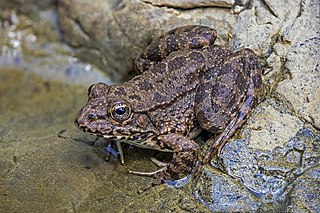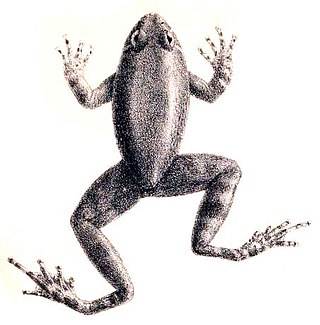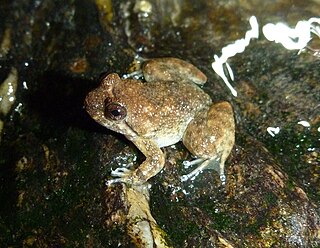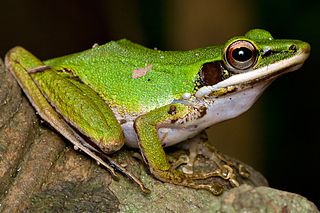
True frogs is the common name for the frog family Ranidae. They have the widest distribution of any frog family. They are abundant throughout most of the world, occurring on all continents except Antarctica. The true frogs are present in North America, northern South America, Europe, Africa, and Asia. The Asian range extends across the East Indies to New Guinea and a single species, the Australian wood frog, has spread into the far north of Australia.

Leptobrachella is a genus of frogs in the family Megophryidae. Members of Leptobrachella are found throughout Asia including on Borneo and the Natuna Islands. They are sometimes referred to as Borneo frogs, slender-armed frogs, or dwarf litter frogs. The genus contains over 82 species with 25 found in China alone.

Microhyla berdmorei is a species of narrow-mouthed frog found in eastern India, Bangladesh, southernmost China (Yunnan), Mainland Southeast Asia as well as Borneo and Sumatra. Frogs from Bangladesh probably represent an unnamed species.

Phrynoidis juxtasper, also known as the giant river toad or Borneo river toad, is a species of toad in the family Bufonidae. It is found in Borneo and Sumatra (Indonesia) below 1,600 m (5,200 ft) asl. Prior to its species description, it was confused with Phrynoidis asper.

Nanohyla perparva is a diminutive species of frog in the family Microhylidae. It is endemic to Borneo and found in Kalimantan (Indonesia), Brunei, and Sabah and Sarawak (Malaysia). The nominal species includes distinct lineages that likely represent different species. Common names least narrow-mouthed frog and Labang forest rice frog have been proposed for this species.

The seep frog or Balu oriental frog is a species of frog in the family Dicroglossidae. It is probably endemic to Borneo.

Occidozyga semipalmata is a species of frog in the family Dicroglossidae. It is endemic to western and northern Sulawesi, Indonesia. It has been found in Gunung Lombobatang Natural Reserve, Lore Lindu National Park, and Bogani Nani Wartabone National Park.

Polypedates colletti is a species of frog in the family Rhacophoridae. It is found in the Malay Peninsula, southern Vietnam, Borneo, Sumatra, and islands of the South China Sea.

Polypedates macrotis, commonly known as the dark-eared treefrog, sometimes also Bongao tree frog, Bongao bubble-nest frog, Baram whipping frog, or brown-striped tree frog, is a species of frog in the family Rhacophoridae. It is found in the central peninsular Thailand, Sumatra, Borneo, and Sulu Archipelago as well as a range of other Philippine islands.

Polypedates otilophus is a species of frog in the family Rhacophoridae. It is endemic to Borneo where it is widespread and found in Brunei, Indonesia, and Malaysia, typically in the lowlands but sometimes as high as 1,100 m (3,600 ft) above sea level. This species has prominent, sharp ridges behind the eye, above the ear, referred to in its names.
Djoko Tjahjono Iskandar is an Indonesian herpetologist who studies the amphibians of Southeast Asia and Australasia. He is a professor of biosystematics and ecology at Bandung Institute of Technology in West Java, Indonesia.

Sumaterana crassiovis is a species of true frog. It is endemic to Sumatra, Indonesia. It is also known as the Bander Baru frog, Korinchi frog, and Kerinci cascade frog.

Chalcorana megalonesa is a species of true frog in the family Ranidae, the "true frogs". It is endemic to Borneo and is known from both Malaysia and Indonesia (Kalimantan). It was split off from Rana chalconota in 2009 by Robert Inger and colleagues, along with a number of other species. Common name large white-lipped frog has been coined for it.

Chalcorana raniceps, also known as the copper-cheeked frog, white-lipped frog, or Peters' Malaysian frog, is a species of "true frog" in the family Ranidae. It is endemic to Borneo, including Brunei Darussalam, Kalimantan (Indonesia), and Sarawak (Malaysia), although it is likely to occur more widely. Previously mixed with Chalcorana chalconota and believed to have much wider distribution, its range was delimited to Borneo in the revision of "Rana chalconota" complex by Robert Inger and colleagues in 2009.

Alcalus rajae, sometimes known as king dwarf mountain frog, is a species of frog in the family Ceratobatrachidae, subfamily Alcalinae. It is endemic to Kalimantan, Borneo (Indonesia), and known from its type locality in the Bukit Baka Bukit Raya National Park, as well as the Gunung Penrissen Nature Reserve, both in the West Kalimantan province, and from the Meratus Protected Forest in the South Kalimantan province. The specific name rajae refers to the type locality: Bukit Raya is the highest mountain in Kalimantan, getting its name from the Indonesian word raya, signifying the majestic size of the peak. It also alludes to the relatively large size of this species relative to its (then) congeners.
Leptobrachella bondangensis is a species of frog in the family Megophryidae. It is endemic to Central Kalimantan, in the Indonesian part of Borneo, and is only known from its eponymous type locality, Mount Bondang in the Murung Raya Regency. Common name Bondang dwarf litter frog has been coined for this species.
Pulchrana fantastica, also known as the splendid stream frog, is a species of "true frog", family Ranidae. It is endemic to northern Sumatra (Indonesia) and is currently known from the Aceh and North Sumatra provinces. Its nearest relatives are Pulchrana centropeninsularis and Pulchrana siberu. The specific name fantastica is derived from the Greek phantastikós and refers to the "extraordinary beauty" of this frog.
Pulchrana centropeninsularis is a species of "true frog", family Ranidae. It is found in Peninsular Malaysia and Sumatra (Indonesia). The specific name centropeninsularis refers to the area of its original discovery, the state of Pahang in the central Peninsular Malaysia. Later on, it has also been recorded in the province of Jambi in east-central Sumatra. Pulchrana centropeninsularis is a rare species known from few individuals only. Prior to its description, Pulchrana centropeninsularis was confused with Pulchrana siberu, its closest relative.
Sigalegalephrynus is a genus of toads in the family Bufonidae. Species are commonly known as puppet toads.














